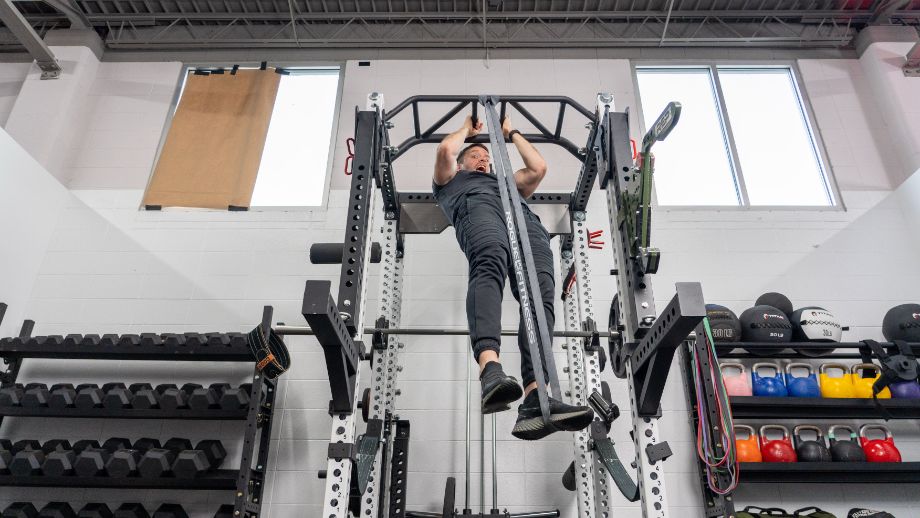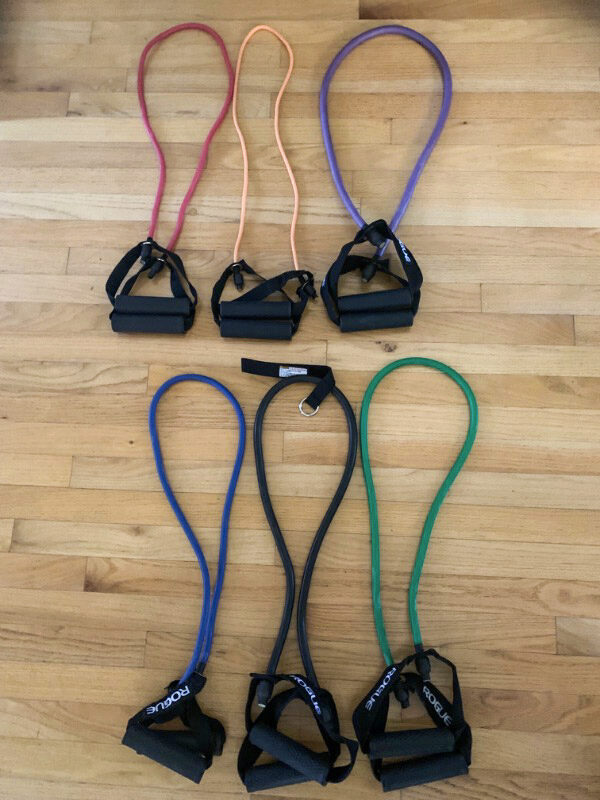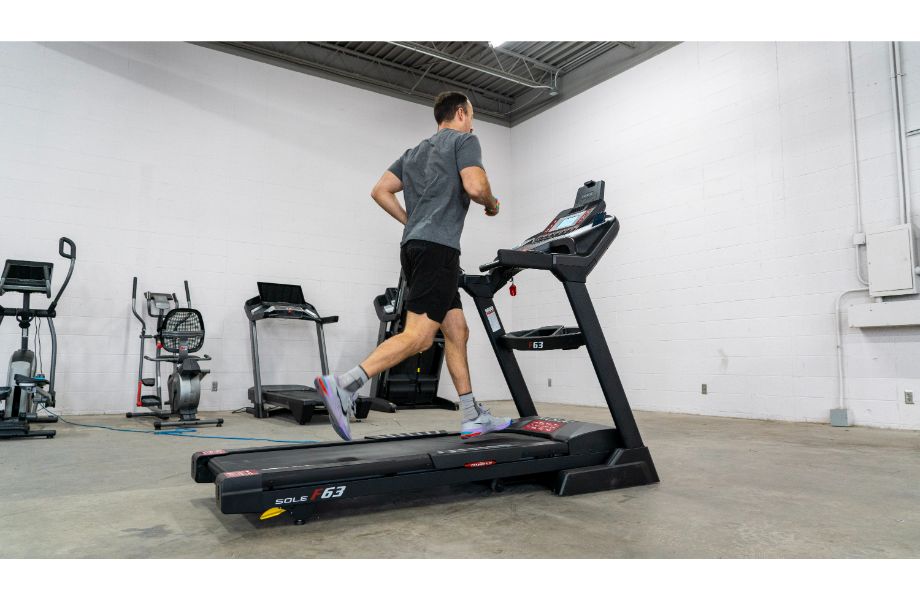You can’t argue with the convenience of resistance bands. They’re lightweight, versatile, portable, and inexpensive. With only a few bands of varying resistance levels, you’re able to get an excellent workout at home, on the go, or wherever you find yourself.
There are many benefits of resistance bands and using them, but how effective are resistance bands really? What does scientific research indicate?
We’re putting resistance band exercises toe-to-toe today with free weights, bodyweight exercises, and plyometrics to determine how to get the best results from your workout routine.
Ready to find out how they stack up when science is involved?
Let’s get after it!
Related: A Complete Guide To Using Resistance Bands Effectively
Resistance Bands vs Free Weights

The heavyweight bout pits resistance bands against the tried-and-true, commonly considered “best” way to build muscle and make strength gains—free weights.
Free weights include barbells, dumbbells, kettlebells, and just about any other piece of gym equipment you could pick up and put back down multiple times. There are exercises available to target virtually every muscle group of your body using free weights as resistance.
Resistance bands differ from free weights in two key ways: the type of resistance and the amount of resistance possible.
Whereas free weights weigh the same regardless of where it is in the exercise’s range of motion, resistance bands provide dynamic, elastic resistance, which becomes more challenging the more stretched it becomes. That means you’ll feel an exercise get harder as you reach the end of the movement during resistance band training while free weight training should not have this same effect.
Regarding the amount of resistance possible, free weights edge out their elastic band counterparts by offering the ability to provide significantly more resistance.
Resistance bands can offer some heavy resistance, maxing out at 200 pounds if you have the set of Rogue Monster Bands, but a barbell can be loaded with plate after plate and result in significantly more weight than that. This is one reason why people who lift heavy weights tend to prefer barbells over resistance bands regardless of the research.
And now, the moment you’ve been waiting for! What does the research say? How does resistance band training really stack up against free weight training?
A 2017 study performed by the European Journal of Sport Science1 compared multi-joint exercises using elastic resistance bands (ERB) and conventional resistance-training equipment (CRE) to determine if ERBs are a feasible alternative to CRE.
The study concluded “that ERB can be a feasible training modality for lateral pulldowns, unilateral rows and to some extent stiff-legged deadlifts, but not for the squat exercise” based on the observed muscular activation.
Related: How To Squat With Resistance Bands
A meta-analysis published by SAGE Open Medicine2 in 2019 endeavored to utilize data from qualifying studies and determine “the effects of resistance training with elastic devices and conventional devices on the outcome muscular strength.”
The results “showed that there is no superiority between training performed with elastic resistance and training with weight machines and/or free weights on strength gain.”
These findings indicate that resistance bands, when utilized properly, can provide similar muscular activation and strength gains commensurate to free weight training.
Related: Free Weights Vs Resistance Bands: Which Is The Ultimate Muscle-Building Tool?
Resistance Bands vs Bodyweight Exercises

Beginners often balk at the use of exercise equipment of all kinds, preferring to stick with bodyweight exercises. Luckily, resistance bands are very straightforward and beginner-friendly. Plus, exercise bands are inexpensive, so you won’t break the bank buying a comprehensive set for your home gym.
How do resistance bands fare against bodyweight exercises though?
A meta-analysis published by Frontiers in Physiology3 analyzed data from 15 different studies, 18 trials, and a total of 669 individuals “to determine the effects of different forms of resistance training on body composition and muscle strength in overweight and/or obese people.”
“The results showed that resistance bands improved body fat in overweight or obese people better than other resistance training types,” which included free weight training and bodyweight training.
Bodyweight exercises, on the other hand, were deemed “better for increasing skeletal muscle mass in overweight or obese people.” In regard to increases in body strength, the analysis observed “no significant difference” between resistance band training, free weight training, and bodyweight training.
According to these results, there are pros and cons to both resistance band training and bodyweight exercises.
Related: Jump Outside Of The Box: Try These 6 Challenging Bodyweight Exercises
Resistance Bands vs Plyometrics

Plyometrics is a special type of training that involves using explosive movements to build speed and power. Because resistance training, using resistance bands or otherwise, is very different from plyometric training, it is difficult to determine which is superior to the other.
A 2018 study performed by the Journal of Strength and Conditioning Research4 sought to measure the effect of plyometric training versus resistance training, specifically on lower body muscular performance. Although one test group in the study participated in resistance training only, it is unclear if resistance bands were used at any point during the study.
The results of the study determined that both the plyometric training group and the resistance training group saw similar improvements across all tests with exception to the vertical jump test, in which the plyometric training group significantly improved compared to the other two groups in the study.
Of course, it makes sense that a plyometric-focused workout would result in plyometric-specific improvements, but what else does research tell us regarding resistance band training versus plyometrics?
Unfortunately, not much clinical data is out there directly comparing the two. There are, however, studies completed regarding using resistance bands during plyometric training to maximize the effect.
A 2020 study published by Frontiers in Physiology5 posited that “a combination of plyometric and elastic band training” would provide superior gains to handball athletes regarding speed, agility, and the ability to change direction when compared to traditional training methods, including Smith machines, weighted vests, barbells, and dumbbells.
The results determined that “elastic band loaded plyometric training” is a very effective tool.
While the study centered around handball, it is reasonable to assume that other sports with similar speed and agility requirements could also benefit from a routine that incorporates resistance bands during plyometric exercise.
Related: Develop Power With The 7 Best Plyometric Exercises
How to Train With Resistance Bands

Overall, resistance band training is very effective, whether performed exclusively, combined with other exercise types, or used rotationally in a well-rounded regimen. Incorporating resistance bands in your routine shouldn’t pose much of a challenge, as many standard exercises could easily include a resistance band.
For example, beginners may use resistance bands for difficult bodyweight exercises like the pull-up to make things more manageable and essentially practice the movement with less resistance to start. Bands will make vertical dips easier as well so you can get all the upper body and tricep benefits without overexerting yourself.
Likewise, adding resistance bands to already effective bodyweight exercises, including squats, crunches, glute bridges, and more, increases the level of resistance, employing the principle of progressive overload and helping you build muscle and strength faster than strictly sticking to bodyweight alone.
There’s always a way to add in a resistance band and, since they’re endlessly versatile, you can get a full body workout with one simple piece of equipment. No matter what fitness level you’re at today, throwing resistance bands into your fitness routine is an excellent idea.
Related: The Best Full-Body Resistance Band Workout Exercises
How Effective Are Resistance Bands? Final Thoughts

We, as fitness enthusiasts, love clear-cut answers regarding what’s the best thing to do when we’re getting our sweat on. After all, time is a finite resource, so we want to make sure everything is optimized to get us the best results in the shortest possible time.
Unfortunately, fitness rarely works this way, and we can’t say that resistance band training is objectively better than other forms of training for all applications.
It ultimately depends on your goals.
Overall, incorporating resistance band training is excellent, especially if:
- You are a beginner
- You are prioritizing burning body fat
- You are combining them with plyometric exercise to compound results
- You predominantly perform home workouts and prefer low-profile, inexpensive equipment
Don’t forget—variety is the spice of life! Sometimes swapping out the ol’ barbell for some reps with a resistance band will help you keep things fresh and help you push to new heights.
The data shows it’s often just as good as most other forms of exercise and resistance training, so why not give it a try?
How Effective Are Resistance Bands? Q&A
What are the best types of resistance bands to use for exercise?
There are many different types of resistance bands available, including long loop bands, handheld bands, mini loop bands, and more. The best resistance band for you will depend on your goals and how you intend to use the band.
Here is a rundown of the best resistance bands to help you narrow down what might work best for your purposes!
What are the disadvantages of resistance bands?
Resistance bands are an incredible tool in the gym, but they are far from without fault.
Cons of resistance bands include:
They wear out over time
They tend to offer lighter resistance versus free weights
It is difficult to measure progress and improvement using them
Are resistance bands good for use during recovery after injury?
Many physical therapists use resistance bands to aid in rehabilitation after an injury by helping improve strength and flexibility without placing undue stress on the joints.
Remember, you should always consult a qualified professional regarding injuries and a recovery plan. Taking matters into your own hands increases your risk of further aggravating your injuries and resulting in even more time spent out of the gym!
References
1. Iversen VM, Mork PJ, Vasseljen O, Bergquist R, Fimland MS. Multiple-joint exercises using elastic resistance bands vs. conventional resistance-training equipment: A cross-over study. Eur J Sport Sci. 2017;17(8):973-982. doi:10.1080/17461391.2017.1337229
2. Lopes JSS, Machado AF, Micheletti JK, de Almeida AC, Cavina AP, Pastre CM. Effects of training with elastic resistance versus conventional resistance on muscular strength: A systematic review and meta-analysis [published correction appears in SAGE Open Med. 2020 Sep 9;8:2050312120961220]. SAGE Open Med. 2019;7:2050312119831116. doi:10.1177/2050312119831116
3. Liu, X., Gao, Y., Lu, J., Ma, Q., Shi, Y., Liu, J., Xin, S., & Su, H. (2021, December 15). Effects of different resistance exercise forms on body composition and muscle strength in overweight and/or obese individuals: A systematic review and meta-analysis. Front Physiol. 18 February 2022 Sec. Exercise Physiology https://doi.org/10.3389/fphys.2021.791999
4. Whitehead, Malcolm T., Scheett, Timothy P., McGuigan, Michael R., Martin, Angel V. A Comparison of the Effects of Short-Term Plyometric and Resistance Training on Lower-Body Muscular Performance. Journal of Strength and Conditioning Research. 32(10):p 2743-2749, October 2018. | DOI: 10.1519/JSC.0000000000002083
5. Aloui G, Hermassi S, Hammami M, et al. Effects of Elastic Band Based Plyometric Exercise on Explosive Muscular Performance and Change of Direction Abilities of Male Team Handball Players. Front Physiol. 2020;11:604983. Published 2020 Dec 16. doi:10.3389/fphys.2020.604983







